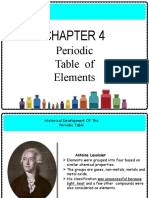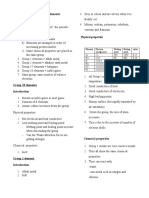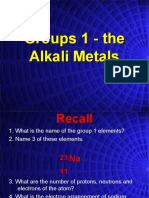Chapter 4: Periodic Table of Element
Uploaded by
rosdyanChapter 4: Periodic Table of Element
Uploaded by
rosdyanCHAPTER 4 : PERIODIC TABLE OF ELEMENT
4.1 Periodic Table
o Elements in the Periodic Table are arranged according to their proton number.
o Horizontal rows are called periods.
o Vertical columns are called groups.
4.2 Groups in the Periodic Table
o Specific name of groups:
Group 1 : Alkali metals
Group 2 : Alkali earth metals
Group 3 – 12 : Transition elements
Group 17 : Halogens
Group 18 : Noble gases
o Type of substances :
Group Type of substances
1,2 and 13 metals
3 to 12 ( transition elements ) metals
14, 15, 16, 17, 18 non-metals
4.3 To determine the position of elements in the Periodic Table
1. Write the electron arrangement of the element.
2. The number of valence electrons group
3. The number of shells period
Example :
Sodium element has a proton number of 11 1 valence electron means
that sodium is in Group 1.
The electron arrangement of a sodium atom = 2.8.1
3 shells means that
sodium is in Period 3.
4.4 Group 18 ( He, Ne, Ar, Kr, Xe, Rn )
o Changes of physical properties when going down group 18( Noble gas).
Properties Changes Explanations
Atomic size increases Because the number of occupied shells increases.
Melting & increase Because
boiling Point i. the atomic size increases when going down the group.
ii. The force of attraction between particles become stronger.
iii. Thus, more heat is needed to overcome the stronger force.
o the gases in group 18 are inert chemically or chemically unreactive and exist as
monoatomic gases because they have stable electron arrangement.
o The uses of noble gases.
Gas uses
Helium To fill weather balloons.
Neon To fill neon light to light up advertisement boards.
Argon To fill electrical bulbs.
4.5 Group 1 ( Li, Na, K, Rb, Cs, Fr )
o Physical properties:
Conduct electricity and heat
Softer, low melting/ boiling point and less dense compared to other metals.
o Changes of properties when going down group 1( Alkali metals).
Properties Changes Explanations
Atomic size increases Because the number of occupied shells increases.
Melting & boiling decrease Because
Point i. the atomic size increases when going down the group.
ii. The metal bond between atoms become weaker.
iii. Thus, less heat is needed to overcome the weaker bond.
Reactivity increases Because
(Electropositivity— i. The atomic size/radius increases when going down the group.
strength to release ii. The valence electron in the outermost shell becomes further from the
electron) nucleus.
iii. The force of attraction of nucleus on the valance electron become weaker.
iv. The valence electron becomes easier to be released.
o Chemical properties
Chemical properties Chemical equations
Reacts with water to produce alkaline metal hydroxide 2 X + 2 H2O 2 XOH + H2
solutions and hydrogen gas.
Burns in oxygen gas to produce white solid metal oxides. 4 X + O2 2 X2O
Burns in chlorine gas to form white solid metal chloride. 2 X + Cl2 2 XCl
X = metals in group 1( Li, Na, K, Rb, Cs, Fr )
4.6 Group 17 ( F, Cl, Br, I, At )
o Physical properties ;
Very low melting and boiling point
Pungent smell and are poisonous
Exist as diatomic molecules at room temperature (F2, Cl2, Br2, I2, At2)
o Changes of properties when going down group 17( Halogens).
Properties Changes Explanations
Atomic size increases Because the number of occupied shells increases.
Melting & boiling increases Because
Point i. the atomic size increases when going down the group.
ii. The force of attraction between particles become stronger.
iii. Thus, more heat is needed to overcome the stronger force.
Reactivity decreases Because
(Electronegativity i. The atomic size/radius increases when going down the group.
– strength to ii. The outermost shell becomes further from the nucleus.
attract electron) iii. The strength to attract one electron into the outermost shell by the nucleus
becomes weaker.
iv. The tendency to receive an electron decrease.
o Chemical properties
Chemical properties Chemical equations
Reacts with water to produce two acids X2 + H2O ⇔ HX + HOX
Reacts with hot iron to form a brown solid, iron (III) 3 X2 + 2 Fe 2 FeX3
halides
Reacts with sodium hydroxide solution, NaOH to form X2 + 2NaOH NaX + NaOX + H2O
sodium halide, sodium halite (I) and water.
X = halogen ( F, Cl, Br, I, At)
4.7 Period 3 ( Na, Mg, Al, Si, P, S, Cl, Ar )
o Changes of properties across Period 3.
Properties Changes Explanations
Atomic size decreases Because across Period 3
i. All the atoms of elements have 3 shells occupied with electrons.
ii. Proton number increases by one unit from one element to the next element
causes the positive charge of the nucleus to increase.
iii. Nuclei attraction on the electrons of the first 3 shells increases causes the
atomic size to decrease.
Electronegativity increases Because across Period 3
(strength to attract i. The atomic size/radius decreases while the positive charge of the nucleus
electron) increases.
ii. The strength of atom to attract electrons also increases.
o Changes in oxide properties across Period 3 from left to right.
Basic oxide amphoteric oxide acidic oxide
Element Sodium Magnesiu Aluminiu Silicon Phosphoru Sulphur Chlorin
m m s e
Acid-base
properties of Base Base amphoteric acid acid acid acid
element oxide
Reaction with √ acid √ acid √ acid X acid X acid X acid X acid
acidic or
alkaline X alkali X alkali √ alkali √ alkali √ alkali √ alkali √ alkali
solution
X = insoluble
√ = soluble
4.8 Transition Elments / metals (Group 3 – Group 12)
o 4 special characteristics of transition elements:
Form ions which have different oxidation numbers.
Form coloured ions / compounds.
Form complex ions.
Act as catalysts in certain reactions.
You might also like
- IGCSE Chemistry A - Notes Chapter 9 - The Periodic Table100% (2)IGCSE Chemistry A - Notes Chapter 9 - The Periodic Table28 pages
- Bab 4 The Periodic Table of Elements 4.1 Periodic Table of ElementsNo ratings yetBab 4 The Periodic Table of Elements 4.1 Periodic Table of Elements6 pages
- Periodic Table 1 A Tlou Last Edit - 230708 - 124501No ratings yetPeriodic Table 1 A Tlou Last Edit - 230708 - 12450117 pages
- 74d22b74-c3d7-48c8-a813-ec00fef32371_Periodic_Table.No ratings yet74d22b74-c3d7-48c8-a813-ec00fef32371_Periodic_Table.6 pages
- Classification of Elements Short Term WorksheetNo ratings yetClassification of Elements Short Term Worksheet7 pages
- A-Level Notes - CHAP 9 - 2016 New Syllabus PDFNo ratings yetA-Level Notes - CHAP 9 - 2016 New Syllabus PDF56 pages
- Atomic Radius: S-Block Elements The Elements Variation in Physical PropertiesNo ratings yetAtomic Radius: S-Block Elements The Elements Variation in Physical Properties8 pages
- Chapter 3, Periodic Table, Bonds, Trends, Metals and AlloysNo ratings yetChapter 3, Periodic Table, Bonds, Trends, Metals and Alloys38 pages
- Trends in Group 2 Elements (Alkaline Earth Metals)No ratings yetTrends in Group 2 Elements (Alkaline Earth Metals)52 pages
- Chapter 6 The Periodic Table - Docx FINAL PDFNo ratings yetChapter 6 The Periodic Table - Docx FINAL PDF16 pages
- Fundamental Principles of Ultrafiltration PDFNo ratings yetFundamental Principles of Ultrafiltration PDF15 pages
- Gao Zhu 2021 The Origin of Magic Angle in Twisted Bilayer Graphene Is Heisenberg S Uncertainty PrincipleNo ratings yetGao Zhu 2021 The Origin of Magic Angle in Twisted Bilayer Graphene Is Heisenberg S Uncertainty Principle8 pages
- Numerical Solution of Hybrid Nanofluid and Its Stability Over Permeable Wedge Sheet With Heat Transfer AnalysisNo ratings yetNumerical Solution of Hybrid Nanofluid and Its Stability Over Permeable Wedge Sheet With Heat Transfer Analysis13 pages
- Adv Funct Materials - 2018 - Ghoshal - Theoretical and Experimental Insight Into The Mechanism For Spontaneous VerticalNo ratings yetAdv Funct Materials - 2018 - Ghoshal - Theoretical and Experimental Insight Into The Mechanism For Spontaneous Vertical12 pages
- Download Complete Physics and Chemistry of Ice Proceedings of the 11th International Conference on the Physics and Chemistry of Ice 1st Edition W. Kuhs PDF for All Chapters100% (3)Download Complete Physics and Chemistry of Ice Proceedings of the 11th International Conference on the Physics and Chemistry of Ice 1st Edition W. Kuhs PDF for All Chapters86 pages
- Copeland Scroll Digital: F-Line Air-Cooled Condensing UnitsNo ratings yetCopeland Scroll Digital: F-Line Air-Cooled Condensing Units2 pages
- MBOTDSC 2.1-Plant-Physiology and BiochemistryNo ratings yetMBOTDSC 2.1-Plant-Physiology and Biochemistry326 pages
- Fast Evaluation of Thermodynamic Properties of Superheated Steam A Cubic Equation of State100% (1)Fast Evaluation of Thermodynamic Properties of Superheated Steam A Cubic Equation of State9 pages
- IIT Bombay Lab Manual Chemical EngineeringNo ratings yetIIT Bombay Lab Manual Chemical Engineering2 pages
- Chemistry - 2 Unit: Year 12 HSC Course Half - Yearly ExamNo ratings yetChemistry - 2 Unit: Year 12 HSC Course Half - Yearly Exam12 pages
- NH 3 H 2 o Oh NH 4 Acid Base Concepts Chapter 15 H Conjugate Acid Base Pairs H Base AcidNo ratings yetNH 3 H 2 o Oh NH 4 Acid Base Concepts Chapter 15 H Conjugate Acid Base Pairs H Base Acid12 pages
- Thermodynamics LAB REPORTS UW-19-ME-BSC-029 Usman AliNo ratings yetThermodynamics LAB REPORTS UW-19-ME-BSC-029 Usman Ali50 pages
- 1999hadjipanayis JMMM Nanophase Hard MagnetsNo ratings yet1999hadjipanayis JMMM Nanophase Hard Magnets19 pages
- IGCSE Chemistry A - Notes Chapter 9 - The Periodic TableIGCSE Chemistry A - Notes Chapter 9 - The Periodic Table
- Chemistry: a QuickStudy Laminated Reference GuideFrom EverandChemistry: a QuickStudy Laminated Reference Guide
- Bab 4 The Periodic Table of Elements 4.1 Periodic Table of ElementsBab 4 The Periodic Table of Elements 4.1 Periodic Table of Elements
- Periodic Table 1 A Tlou Last Edit - 230708 - 124501Periodic Table 1 A Tlou Last Edit - 230708 - 124501
- 74d22b74-c3d7-48c8-a813-ec00fef32371_Periodic_Table.74d22b74-c3d7-48c8-a813-ec00fef32371_Periodic_Table.
- Atomic Radius: S-Block Elements The Elements Variation in Physical PropertiesAtomic Radius: S-Block Elements The Elements Variation in Physical Properties
- Chapter 3, Periodic Table, Bonds, Trends, Metals and AlloysChapter 3, Periodic Table, Bonds, Trends, Metals and Alloys
- Trends in Group 2 Elements (Alkaline Earth Metals)Trends in Group 2 Elements (Alkaline Earth Metals)
- Practice Makes Perfect in Chemistry: The Periodic TableFrom EverandPractice Makes Perfect in Chemistry: The Periodic Table
- GCSE Chemistry Revision: Cheeky Revision ShortcutsFrom EverandGCSE Chemistry Revision: Cheeky Revision Shortcuts
- Practice Makes Perfect in Chemistry: The Periodic Table with AnswersFrom EverandPractice Makes Perfect in Chemistry: The Periodic Table with Answers
- An Introduction to Physics (Material Science Metallurgy)From EverandAn Introduction to Physics (Material Science Metallurgy)
- Practice Makes Perfect in Chemistry: Chemical BondingFrom EverandPractice Makes Perfect in Chemistry: Chemical Bonding
- Gao Zhu 2021 The Origin of Magic Angle in Twisted Bilayer Graphene Is Heisenberg S Uncertainty PrincipleGao Zhu 2021 The Origin of Magic Angle in Twisted Bilayer Graphene Is Heisenberg S Uncertainty Principle
- Numerical Solution of Hybrid Nanofluid and Its Stability Over Permeable Wedge Sheet With Heat Transfer AnalysisNumerical Solution of Hybrid Nanofluid and Its Stability Over Permeable Wedge Sheet With Heat Transfer Analysis
- Adv Funct Materials - 2018 - Ghoshal - Theoretical and Experimental Insight Into The Mechanism For Spontaneous VerticalAdv Funct Materials - 2018 - Ghoshal - Theoretical and Experimental Insight Into The Mechanism For Spontaneous Vertical
- Download Complete Physics and Chemistry of Ice Proceedings of the 11th International Conference on the Physics and Chemistry of Ice 1st Edition W. Kuhs PDF for All ChaptersDownload Complete Physics and Chemistry of Ice Proceedings of the 11th International Conference on the Physics and Chemistry of Ice 1st Edition W. Kuhs PDF for All Chapters
- Copeland Scroll Digital: F-Line Air-Cooled Condensing UnitsCopeland Scroll Digital: F-Line Air-Cooled Condensing Units
- Fast Evaluation of Thermodynamic Properties of Superheated Steam A Cubic Equation of StateFast Evaluation of Thermodynamic Properties of Superheated Steam A Cubic Equation of State
- Chemistry - 2 Unit: Year 12 HSC Course Half - Yearly ExamChemistry - 2 Unit: Year 12 HSC Course Half - Yearly Exam
- NH 3 H 2 o Oh NH 4 Acid Base Concepts Chapter 15 H Conjugate Acid Base Pairs H Base AcidNH 3 H 2 o Oh NH 4 Acid Base Concepts Chapter 15 H Conjugate Acid Base Pairs H Base Acid
- Thermodynamics LAB REPORTS UW-19-ME-BSC-029 Usman AliThermodynamics LAB REPORTS UW-19-ME-BSC-029 Usman Ali

























































































